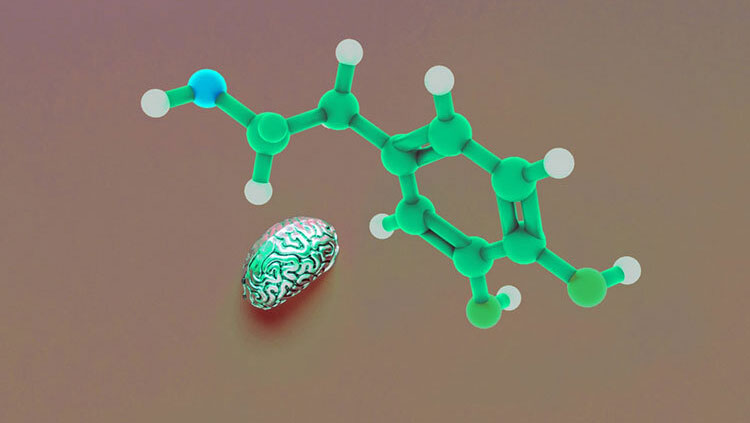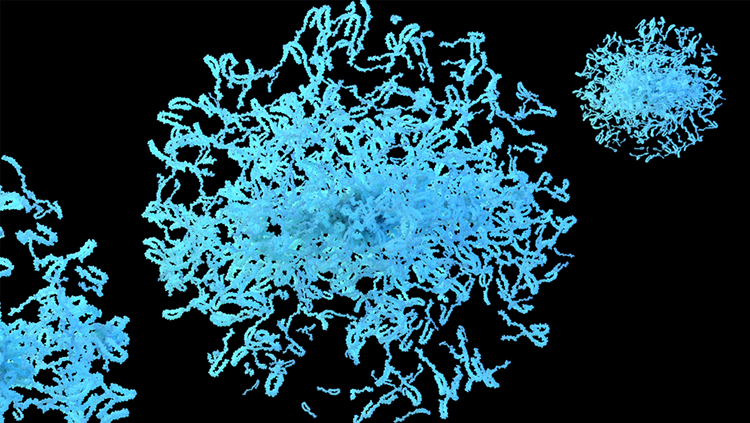Dopamine Can Directly Alter Gene Expression Through the Process of Dopaminylation
- Published5 Dec 2024
- Author Ailie McWhinnie
- Source BrainFacts/SfN

For over sixty years, dopamine has been defined by its ability to transmit signals between neurons. But the discovery of a process called “dopaminylation” suggests this neurotransmitter can also directly alter protein function and gene expression.
Through dopaminylation, dopamine can bind to proteins inside cells and modify their activity or function. At Neuroscience 2024, the Society for Neuroscience’s annual meeting in October, researchers shared evidence of impaired dopaminylation in people with Parkinson’s disease as well as aged mice, raising new questions about how dopamine depletion contributes to the disease.
“Traditionally, dopamine is thought to regulate most of [its] functions via its role as a neurotransmitter,” explained Winnie Chen, a neuroscientist at the Icahn School of Medicine at Mount Sinai, New York. But that has changed with recent discoveries. “Dopamine not only acts as a cell-to-cell communication messenger, but also as a modification on proteins,” Chen said.
Not Just a Neurotransmitter
In a 2020 Science publication, a team led by neuroscientist Ian Maze at the Icahn School of Medicine at Mount Sinai, New York, reported a neurotransmission-independent role for dopamine in both rats and humans. They found dopamine could bind to histone, a protein that regulates gene expression by controlling access to DNA. By binding histone, dopamine could change gene expression — helping turn genes on and off and alter cells’ functions.
The study focused on the role of dopaminylation in addiction, a disorder linked to dysfunction in the dopamine reward system. The researchers found rats experiencing cocaine withdrawal accumulated dopaminylation marks in the ventral tegmental area, a brain region critical to the dopamine reward system. They think dopaminylation in the region made the rats more susceptible to relapse when given access to cocaine again.
The team found if histone dopaminylation was blocked, the rats reduced their drug-seeking behavior upon re-exposure to cocaine, and typical dopamine signaling patterns were restored. Further work is needed to uncover which genes can be regulated by dopaminylation, but it is clear it can impact neuronal function and, ultimately, behavior.
Since the initial discoveries, the team found dopamine regulates more than histone protein. By investigating four areas of the mouse brain known to send or receive dopamine signals with a specially designed probe labeling proteins bound with dopamine, the researchers found over 1,500 unique dopaminylated proteins, many of which are involved in synaptic function, indicating it has widespread effects throughout the brain beyond its role as a neurotransmitter as noted in a preprint study posted September 2024.
Diverse Effects of Dopamine Depletion in Parkinson’s Disease
In Parkinson’s disease, people experience a gradual loss of dopamine-producing neurons. As dopamine cells are lost, dopamine signaling decreases, impairing functions including movement and motivation.
The risk of Parkinson’s increases with age, so the team at Mount Sinai wondered if changes to dopaminylation could be at play. In pre-publication studies presented at Neuroscience 2024, they reported a decrease in dopaminylated proteins in the mouse brain with age, and many of the affected proteins were associated with the risk of neurodegenerative diseases.
They also collected post-mortem brain tissue samples from Parkinson’s patients to look at dopaminylation in the human brain. They were interested in the prefrontal cortex — an area important for complex cognition — because the dementia and cognitive decline commonly seen in people with Parkinson’s are associated with this brain area. Here, they saw fewer dopaminylated proteins compared to those without the disease, showing Parkinson’s hallmark depletion of dopamine may alter protein function within neurons, not just signaling.
Researchers do not know whether the degeneration of dopamine neurons drives the decrease in dopaminylation across the brain, or whether the drop in dopaminylation drives degeneration. “It’s kind of like the chicken and the egg,” Chen said. “If we get the data of which genes [dopamine] is regulating, we might have an insight into what its function is — whether it’s a protective mechanism or a result.”
This protein modification process has been seen in other closely-related neurotransmitters, namely serotonin and histamine. Collectively, the modification processes across these neurotransmitters have been dubbed “monoaminylation.” An enzyme called transglutaminase-2 mediates monoaminylation across all three cases.
The findings prompt speculation about dopaminylation-based therapies, but designing a drug to target only dopaminylation would be difficult. “The enzyme itself, transglutaminase-2, has so many functions in the brain. It doesn't just do that one [task] — monoaminylation — and so I think there's many reasons why we cannot just modulate the enzyme,” explained Chen.
For now, though, the discovery introduces new considerations for researchers studying any of the brain’s dopamine systems — from the olfactory system and vision to movement and motivation — as its production and release may have far more complex effects than imagined.
CONTENT PROVIDED BY
BrainFacts/SfN
References
Farrelly et al., (2019). Histone serotonylation is a permissive modification that enhances TFIID binding to H3K4me3. Nature 567, 535–539. https://doi.org/10.1038/s41586-019-1024-7
Girault (2020). Epigenetic tinkering with neurotransmitters. Science 368,134-135(2020) https://doi.org/10.1126/science.abb3533
Kachak and Maze (2023). Post-translational modifications of histone proteins by monoamine neurotransmitters. Curr Op. Chem Biology 74. https://doi.org/10.1016/j.cbpa.2023.102302
Lepack et al., (2020). Dopaminylation of histone H3 in ventral tegmental area regulates cocaine seeking. Science 368,197-201 https://doi.org/10.1126/science.aaw8806
Stewart et al., (2024). Hippocampal γCaMKII dopaminylation promotes synaptic-to-nuclear signaling and memory formation. BioRxiv. https://doi.org/10.1101/2024.09.19.613951
What to Read Next
Also In Genes & Molecules
Trending
Popular articles on BrainFacts.org



















